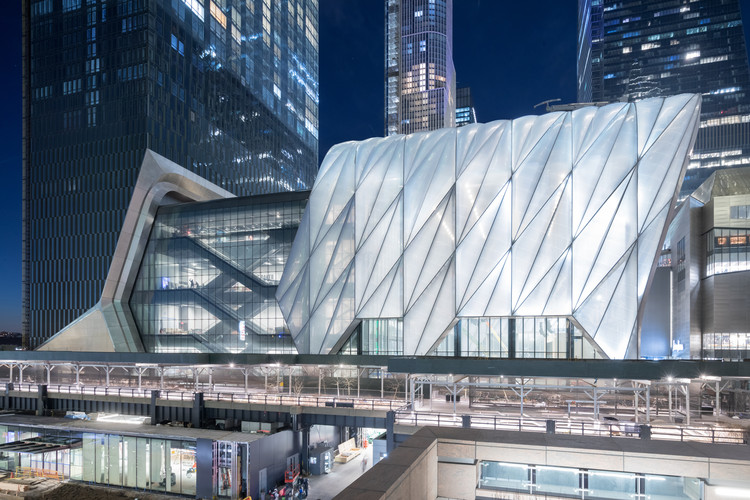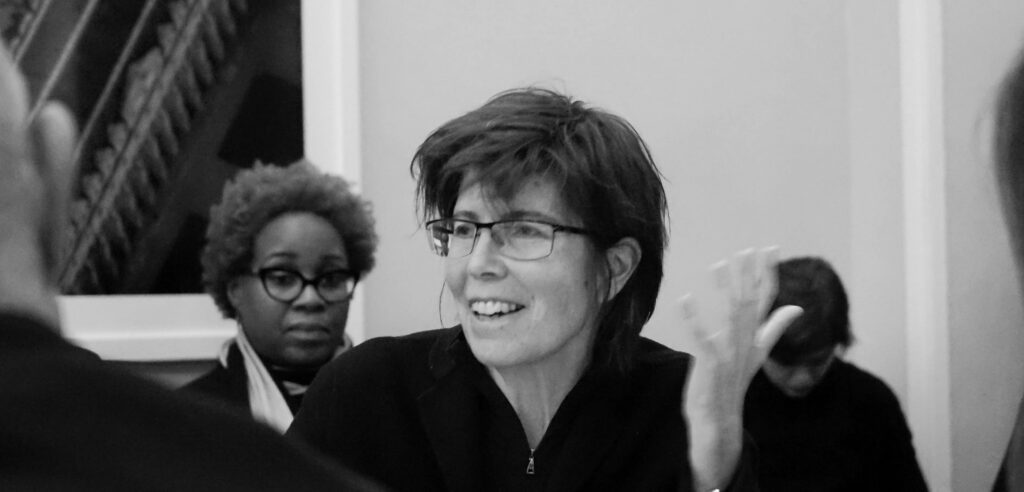Photo: Geordie Wood




A 2-day immersion into the future of sustainable construction
Who is Elizabeth Diller?
Elizabeth Diller stands as a towering figure in the world of contemporary architecture. Born into the rhythms of urban life, she carved out a unique niche for herself and her firm, Diller Scofidio + Renfro (DS+R). Known for her intellectually driven and interdisciplinary approach, Diller’s work is often at the intersection of architecture and art, challenging the conventional boundaries of both fields.
Quick Facts
| Birthplace | Poland (emigrated to the U.S.) |
|---|---|
| Education | Cooper Union, New York |
| Firm | Diller Scofidio + Renfro |
| Known for | The High Line, The Shed, MoMA Expansion |
| Notable Awards | MacArthur “Genius” Grant, Time 100 Most Influential People |
Major Influences
Elizabeth’s design philosophy is deeply influenced by her interest in visual arts and the role of public spaces in urban environments. Her projects often reflect a blend of these passions, aiming to create spaces that provoke thought and engage the public.
Formation and Philosophy of Diller Scofidio + Renfro
Formed in the late 1970s, Diller Scofidio + Renfro started as a radical experiment in the blending of architecture, art, and performance. The firm, co-founded by Elizabeth Diller and Ricardo Scofidio, grew from a provocative, conceptually oriented practice into one of the most innovative architecture firms in the world today.
The Philosophy Behind the Designs
At its core, DS+R champions architecture as a multidisciplinary practice, merging landscape architecture, visual arts, and digital media with traditional building design. This approach is not just about constructing spaces but about creating experiences that transform perceptions of space and community.
Core Values of DS+R
- Innovation: Pushing the boundaries of traditional architecture.
- Integration: Blending architecture with other forms of art and technology.
- Interaction: Designing spaces that encourage public engagement and interaction.
- Interdisciplinary: A holistic approach that incorporates diverse fields of study.
Pioneering Projects
DS+R’s portfolio includes some of the most complex and high-profile projects in urban settings around the world. Each project reflects the firm’s commitment to reimagining and revitalizing public spaces.


The High Line (New York City): Transforming a derelict elevated rail line into a vibrant urban park.


The Broad (Los Angeles): A contemporary art museum known for its honeycomb-like façade and extensive collections.


The Shed (New York City): A cultural center with a retractable shell that adapts to host a range of performances and events.
Elizabeth Diller’s Approach to Public Spaces
Elizabeth Diller’s design philosophy extends deeply into the functionality and accessibility of public spaces. Her projects aim to make high-quality architecture accessible to all, fostering community interaction and engagement.
Principles of Public Space Design
- Accessibility: Ensuring all community members can enjoy the space.
- Engagement: Encouraging active participation in the space’s activities.
- Sustainability: Designing with environmental considerations in mind.
- Flexibility: Allowing the space to serve multiple purposes and adapt to future needs.
Elizabeth Diller: Cultural and Civic Projects
Elizabeth Diller’s approach to architecture goes beyond mere construction; it engages with the cultural and civic life of the communities her projects serve. These projects often become landmarks and central hubs for art, education, and social interaction.
Impactful Cultural Projects
Diller’s projects often emphasize cultural significance and social impact. Here are a few standout examples:
| Project | Location | Cultural Significance |
|---|---|---|
| The Shed | New York City, USA | A cultural center with a modular design to host diverse art forms. |
| Columbia Business School | New York City, USA | Designed to foster collaboration and innovation in education. |
| The Museum of Modern Art (MoMA) Expansion | New York City, USA | Enhances one of the world’s leading modern art collections. |
Elizabeth Diller and Innovations in Architecture and Design
Elizabeth Diller’s work is characterized by a relentless pursuit of innovation in architectural design, pushing the boundaries of what buildings can represent and how they function within their urban landscapes.
Innovative Design Techniques
Diller has embraced a variety of innovative techniques and materials in her projects to enhance their functionality and aesthetic value. Some key innovations include:
- Responsive Architecture: Use of adaptive materials and designs that respond to environmental conditions.
- Integrating Digital Media: Incorporating digital elements into physical spaces to create dynamic environments.
Examples of Innovative Projects
- Blur Building (Yverdon-les-Bains, Switzerland): An architecture of atmosphere, the Blur Building is a structure shrouded in fog, created by water pumped from the lake below and sprayed through high-pressure fog nozzles.
- Bubble at Hirshhorn Museum (Washington, D.C., USA): A temporary inflatable structure proposed to extend the museum space and host special exhibitions.
The Role of Technology in Elizabeth Diller Designs
Elizabeth Diller has consistently leveraged cutting-edge technology to enhance both the aesthetic and functional aspects of her architectural projects. This integration not only reflects her innovative spirit but also her foresight in utilizing technology to push architectural boundaries.
Technological Innovations in Architecture
- Digital Fabrication: Diller has utilized advanced digital fabrication techniques to achieve intricate designs that would be impossible with traditional construction methods.
- Interactive Installations: Many of Diller’s projects include interactive elements that engage the audience, such as responsive lighting and multimedia installations that change based on viewer presence or behavior.
Impact of Technology on Design Efficiency
- Simulation Tools: Advanced simulation tools allow for better planning and testing of architectural responses to environmental factors, reducing the need for physical prototypes.
- Sustainability Technology: Technologies that promote energy efficiency and reduce the carbon footprint are integral to her designs, supporting the creation of more sustainable urban environments.
Philanthropy and Community Engagement
Elizabeth Diller’s commitment to architecture transcends her professional work, extending into philanthropy and community engagement. Her initiatives often focus on enriching communities through accessible design and educational opportunities.


Elizabeth Diller and Philanthropic Efforts
- Public Access Projects: Diller has worked on several projects aimed at providing free access to cultural and educational facilities, such as public libraries and community centers.
- Scholarships and Funding: She supports scholarships and grants for aspiring architects, particularly those from underrepresented backgrounds.
Community Initiatives
- Urban Renewal Projects: Through her urban projects, Diller aims to revitalize neglected areas, turning them into vibrant community spaces that encourage social interaction and cultural activities.
- Educational Workshops: Hosting workshops and lectures, Diller engages directly with communities to discuss the role of architecture in public welfare and urban development.
Elizabeth Diller: Challenges and Controversies
Like many pioneers in their field, Elizabeth Diller has faced her share of challenges and controversies, each shaping her approach and philosophy in unique ways.
Notable Controversies
- Cultural Displacement: Some of Diller’s projects, like the High Line, have been criticized for contributing to gentrification and cultural displacement in previously diverse neighborhoods.
- Design Critiques: Certain projects have faced criticism for overemphasis on form over function, raising debates on the practical aspects of avant-garde architecture.
Overcoming Challenges
- Community Engagement: In response to criticisms, Diller has increased efforts to engage with local communities during the planning phases of new projects to better align with their needs and expectations.
- Adaptive Design Practices: Learning from past experiences, DS+R has adapted its design practices to be more inclusive of environmental and social considerations.
Elizabeth Diller: Legacy and Future Influence in Architecture
Elizabeth Diller’s influence on contemporary architecture is profound and enduring. Her innovative approach and willingness to challenge conventional norms have paved the way for future generations of architects.
Architectural Legacy
- Interdisciplinary Approach: Diller’s work has encouraged a more interdisciplinary approach in architecture, influencing educational programs and professional practices worldwide.
- Public Space Redefinition: Her projects have redefined public spaces, making them more inclusive and interactive, which has influenced urban planning globally.
Future Influence
- Mentorship and Advocacy: As a mentor and advocate for the next generation of architects, Diller continues to inspire young professionals to explore the intersection of technology, art, and architecture.
- Sustainable Design Leadership: Looking ahead, her focus on sustainable and responsive design is likely to influence industry standards, promoting more environmentally conscious approaches in architecture.
Elizabeth Diller’s journey through the realms of architecture and beyond illustrates a relentless pursuit of innovation, a deep commitment to community, and a profound influence on the built environment. Her legacy is one of inspiration, challenging the status quo and encouraging future architects to dream big and think differently.
If you want o learn about our consultancies in Portuguese language, click here.






A 2-day immersion into the future of sustainable construction

